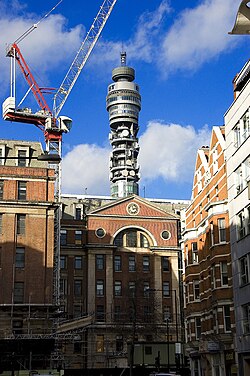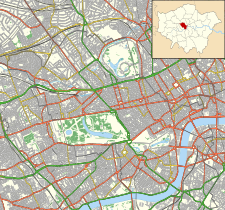Middlesex Hospital
| Middlesex Hospital | |
|---|---|
 | |
 The hospital in September 2007, shortly before demolition (BT Tower in background) | |
| Geography | |
| Location | Fitzrovia, London, England |
| Coordinates | 51°31′08″N 0°08′16″W / 51.5190°N 0.1377°W |
| Organisation | |
| Care system | NHS England |
| Type | General |
| Affiliated university | University College London |
| Services | |
| Emergency department | Yes |
| History | |
| Opened | 1745, moved 1757, rebuilt 1928 |
| Closed | 2005 |
| Links | |
| Lists | Hospitals in England |
Middlesex Hospital was a teaching hospital located in the Fitzrovia area of London, England. First opened as the Middlesex Infirmary in 1745 on Windmill Street, it was moved in 1757 to Mortimer Street where it remained until it was finally closed in 2005. Its staff and services were transferred to various sites within the University College London Hospitals NHS Trust. The Middlesex Hospital Medical School, with a history dating back to 1746, merged with the medical school of University College London in 1987.
History
[edit]
Development of the hospital
[edit]The first Middlesex Hospital, which was named after the county of Middlesex, opened as the Middlesex Infirmary in Windmill Street in 1745.[1] The infirmary started with 15 beds to provide medical treatment for the poor.[1] Funding came from subscriptions and, in 1747, the hospital became the first in England to add lying-in (maternity) beds.[1] Prior to 1773, the wards in the hospital were named as 'Mens long ward', 'Mens square ward up one pair of stairs' or 'two pairs of stairs'. Names of wards later followed after the chief nurse of each ward. Naming of wards for several governors and medical staff of the hospital began with wards Percy, Clayton, Villeneau and Pyke, named after Hugh Percy, 1st Duke of Northumberland, Sir Kenrick Clayton, John Villeneau and the benefactor Pyke, respectively. The large amount local construction work resulted in one-in-four admissions being due to trauma, and Percy ward became the accident ward.[2]
The foundation stone for the second Middlesex Hospital, in Mortimer Street, was laid by the hospital's president, the Earl of Northumberland, in 1755.[1] The central block of the new hospital opened in 1757.[1]
Over the years extra wings were added but, in 1924, it was decided that the building was structurally unsound and an entirely new building would be required.[1] The Duke of York, later King George VI, having visited the hospital on 26 June 1928 to lay the foundation stone of the new building, returned on 29 May 1935 to open the completed building.[1] The hospital had been completely rebuilt, on the same site and in stages, without ever being closed, paid for by more than £1 million of donations from members of the public.[3]
After coming under the management of the Bloomsbury Health Authority in 1980, the Middlesex Hospital became associated with various specialist hospitals in the local area.[1] In 1992 the local urology hospitals, St Paul's, St Peter's and St Philip's, were closed down with services transferred to new accommodation in the Middlesex Hospital.[1]
Middlesex Hospital Medical School
[edit]The Middlesex Hospital Medical School traced its origins to 1746 (a year after the foundation of the Middlesex Hospital), when students were 'walking the wards'. The motto of the medical school, Miseris Succurrere Disco, was provided by one of the deans, Dr William Cayley, from Virgil's passage about Queen Dido aiding a shipwreck: Non ignara mali, miseris succurrere disco ("Not unacquainted with misfortune myself, I learn to succour the distressed").[4]
At the establishment of the then London University (now University College London), the governors of the Middlesex Hospital declined permission of the former's medical students to use the wards of the Middlesex Hospital for clinical training. This refusal prompted the foundation of the North London Hospital, now University College Hospital, in 1834.[5]
The medical schools of the Middlesex Hospital and University College Hospital merged in 1987 to form the University College and Middlesex School of Medicine (UCMSM). UCMSM itself merged with the Royal Free Hospital School of Medicine in 1998 to form the UCL Medical School.[6]
The Courtauld Institute of Biochemistry of the Middlesex Hospital Medical School was opened by Samuel Courtauld in 1928, the foundation stone having been laid on 20 July 1927. Its main entrance was in Riding House Street. Courtauld also endowed a Chair of Biochemistry.[1][7]
Closure and redevelopment
[edit]The Middlesex Hospital closed in December 2005.[1] The main hospital building in Mortimer Street was sold to developer Project Abbey (Guernsey) Ltd, a company controlled by Christian and Nick Candy, and was demolished in 2008. The building was used, just before it was demolished, in the film Eastern Promises.[8] Candy and Candy failed in plans to redevelop the site into a 273-apartment luxury accommodation complex, named "NoHo Square", and transferred the property to the nationalised Icelandic bank, Kaupthing Bank.[9]
The site was purchased by Clive Bush and Daniel Van Gelder's Exemplar Properties and Aviva Investors in July 2010.[10] Exemplar decided against retaining either the Candy and Candy designs or the NoHo Square name, and instead appointed new architects in Lifschutz Davidson Sandilands and Sheppard Robson to prepare new designs. Following a public exhibition, a planning application for the proposed scheme was submitted in September 2011.[11][12]
Planning consent for the new development, now called Fitzroy Place, was granted in February 2012.[13] The new development, which combines 295 homes with 240,000 sq ft of offices, including the regional headquarters for cosmetics multinational Estée Lauder, was completed in 2016.[14]
Fitzrovia Chapel
[edit]
The former chapel of the Middlesex Hospital by John Loughborough Pearson is now the only surviving building of the hospital. The chapel was completed after the architect's death under the supervision of his son, Frank, also an architect. The chapel was structurally complete by the mid-1920s; the surrounding hospital was then demolished and rebuilt around it between 1928 and 1929. The chapel was not formally opened until 1929, by which time much of the lavish interior decoration of marbles and mosaic in a mix of Italian gothic and romanesque styles had been added, giving it the appearance it broadly retains today. The chapel is a Grade II* Listed building.[15]
The fabric of the chapel was allowed to decline in the closing decades of the Middlesex Hospital, with water ingress through the roof causing substantial damage to the fabric of the building.[16] The chapel fabric and interior was subject to a £2m restoration, and the building re-endowed with maintenance funds by Exemplar Properties. Never consecrated, named or dedicated, the chapel was given the name "Fitzrovia Chapel."[16]
Paintings of Frederick Cayley Robinson
[edit]For nearly 100 years, four giant paintings welcomed visitors to the reception area of the Middlesex Hospital. The Acts of Mercy were painted in 1912 by Frederick Cayley Robinson, a distinctive yet elusive British artist, after being commissioned by Sir Edmund Davis, one of the governors of the hospital. Prior to the demolition of the hospital, the art was purchased by the Wellcome Library.[17]
Notable patients
[edit]People reported to have died there include:
- William Gerhardie, novelist and playwright (1977)[18]
- Peter Sellers, actor (1980)[19]
- Jane Carr, actress (1957)[20]
People who have been treated here include:
- Winston Churchill (1962)[21]
- Jeffrey Bernard (1997)[22]
Notable staff
[edit]Notable staff have included:
- Eva Luckes (8 July 1854 – 16 February 1919) trained at The Middlesex Hospital for three months, probably as a paying probationer for three months from September 1876.[23][24][25] She completed a years training as an ordinary probationer at The Westminster Hospital between August 1877 - August 1878.[23][24] Luckes was Matron of The London Hospital from 1880 to 1919, and was an innovative and influential nursing leader and friend of Florence Nightingale.[23][24][25]
- Charles Bell (1774–1842), lecturer[26]
- Edward Hulme (1812–1876), apprentice of Charles Bell at Middlesex hospital. Surgeon and hospital administrator in New Zealand[27]
See also
[edit]- List of demolished buildings and structures in London
- Central Middlesex Hospital
- North Middlesex Hospital
- West Middlesex Hospital
- John Raymond Hobbs
- List of hospitals in England
References
[edit]- ^ a b c d e f g h i j k "Middlesex Hospital". Lost Hospitals of London. Retrieved 10 May 2018.
- ^ Shaw, C. D.; Winterton, W. R. The Middlesex Hospital: The names of the wards and the stories they tell (PDF). Hertford: Stephen Austin and Sons Ltd. p. 14.[permanent dead link]
- ^ "Hospitals". Derelict London. Retrieved 25 June 2018.
- ^ Tournoy, Gilbert (2006). Humanistica Lovaniensia: Journal of Neo-Latin Studies. Leuven University Press. p. 242. ISBN 978-9058675712.
- ^ "UCLH trust chronology". University College London Hospitals NHS Foundation Trust. Archived from the original on 11 April 2009. Retrieved 10 September 2010.
- ^ "History". UCL Medical School. 7 December 2017. Retrieved 26 June 2018.
- ^ "Courtauld Institute of Biochemistry". Nature. 130 (3274): 163–164. 1 July 1932. Bibcode:1932Natur.130T.163.. doi:10.1038/130163d0.
- ^ "Middlesex Hospital – The Filming Location of Eastern Promises". Abandoned Spaces. 31 July 2017. Retrieved 26 June 2018.
- ^ Keilthy, Paul (31 October 2008). "Noho Square Deal in Ruins". West End News. Retrieved 25 June 2018.
- ^ Hipwell, Deirdre (18 July 2010). "Aviva wins Noho Square scheme". The Independent. Archived from the original on 14 May 2022. Retrieved 25 June 2018.
- ^ Morby, Aaron (26 September 2011). "New plan for former NoHo Square London site". Construction Enquirer. Retrieved 25 June 2018.
- ^ Bar-Hillel, Mira (22 September 2011). "Noho Square finally looks poised for redevelopment". Evening Standard. Retrieved 25 June 2018.
- ^ Loeb, Josh (9 February 2012). "Middlesex Hospital site gets go-ahead to build 300 homes – Permission granted for £750million scheme". Camden New Journal.
- ^ "2 Fitzroy Place launches in style". Exemplar. 10 February 2015. Retrieved 2 August 2017.
- ^ Historic England. "MIDDLESEX HOSPITAL THE CHAPEL (1223496)". National Heritage List for England. Retrieved 1 November 2015.
- ^ a b "Archifacts Sheet – Fitzrovia Chapel" (PDF). Open House London. Retrieved 1 November 2015.
- ^ "Acts of mercy. Oil paintings by Frederick Cayley Robinson, 1915-1920". COPAC. Retrieved 25 June 2018.
- ^ Oxford Dictionary of National Biography, Volume 21. Oxford University Press. 2004. p. 955. ISBN 978-0-19-861371-8.Article by Michael Holroyd.
- ^ Sikov, Ed (2002). Mr Strangelove: A Biography of Peter Sellers. Sidgwick & Jackson. pp. 381–382. ISBN 978-0-233-99883-1.
- ^ Hendry, Michael. "Jane Carr bio". Retrieved 26 September 2010.
- ^ "Winston Churchill: Aspects in Focus". All about shipping. 24 September 2017. Retrieved 1 January 2019.
- ^ "A cigarette, a fond farewell and Jeffrey Bernard takes his leave". The Independent. 6 September 1997. Archived from the original on 14 May 2022. Retrieved 25 March 2020.
- ^ a b c Rogers, Sarah (2022). 'A Maker of Matrons’? A study of Eva Lückes’s influence on a generation of nurse leaders:1880–1919' (Unpublished PhD thesis, University of Huddersfield, April 2022)
- ^ a b c Anthony, Grainne (2011), ‘Distinctness of Idea and Firmness of Purpose. The Career of Eva Luckes; A Victorian Hospital Matron.’ (Unpublished Master of Arts dissertation, London Metropolitan University, 2011).
- ^ a b McGann, Susan (1992). The Battle of the Nurses: A Study of Eight Women who influenced the Development of Professional Nursing, 1880–1930. Scutari Press. pp. 9–34.
- ^ Gordon-Taylor, Sir Gordon; Walls, E. W. (1958). "Sir Charles Bell, His Life and Times". Edinburgh and London: E. & S. Livingstone.
- ^ Belgrave, Michael. "Edward Hulme". Dictionary of New Zealand Biography. Ministry for Culture and Heritage. Retrieved 23 April 2017.
External links
[edit]- Middlesex Hospital
- Hospital buildings completed in 1882
- Buildings and structures completed in 1757
- Hospital buildings completed in the 18th century
- Hospital buildings completed in 1928
- University College London Hospitals NHS Foundation Trust
- 1745 establishments in England
- Hospitals established in the 1740s
- 2005 disestablishments in England
- Defunct hospitals in London
- Demolished buildings and structures in London
- Buildings and structures demolished in 2008
- Fitzrovia

